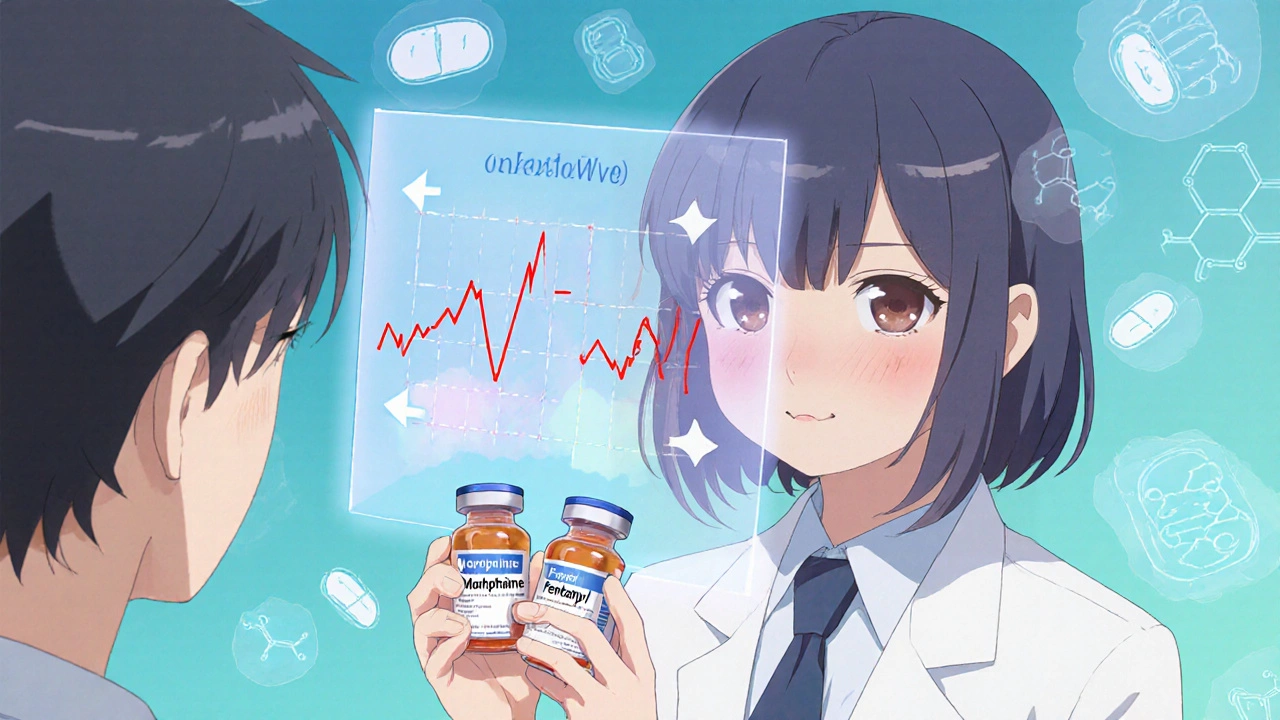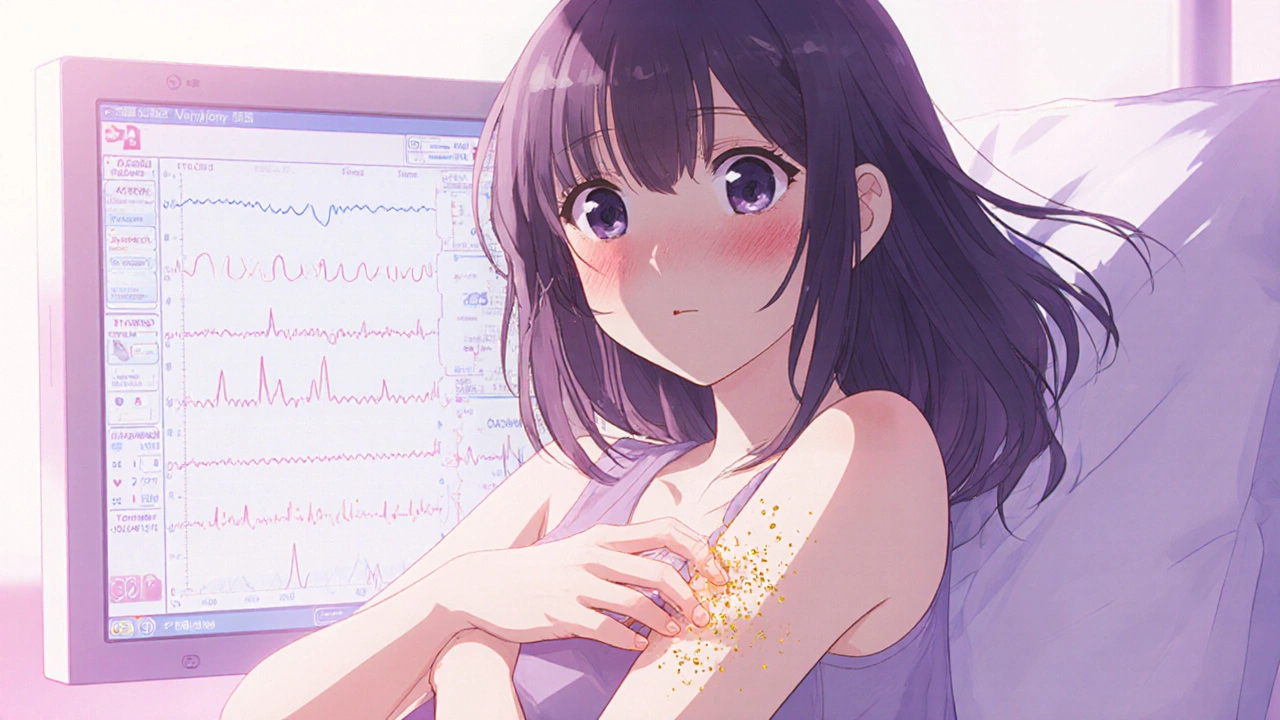Itching after taking an opioid isn’t rare - it’s common. But calling it an "allergy" could be putting your pain management at risk. If you’ve ever felt that unbearable itch after a morphine shot or fentanyl patch and were told you’re "allergic," you’re not alone. But here’s the truth: itching is usually not an allergy. It’s a side effect. And confusing the two can mean missing out on effective pain relief - or being stuck with costlier, less effective drugs.
Itching Isn’t an Allergy - Most of the Time
About 70 to 80% of people who say they’re "allergic" to opioids are actually having a pseudoallergic reaction. That means their body isn’t mounting an immune response. Instead, the opioid is directly triggering mast cells in the skin to dump histamine - the same chemical that makes you itch after a mosquito bite. Morphine is the biggest offender here. It releases 3 to 4 times more histamine than hydromorphone at the same pain-relieving dose. Codeine is similar. But fentanyl? Methadone? They barely trigger it at all. This isn’t just a theory. A 2021 study in Anesthesia & Analgesia showed morphine’s histamine threshold is just 0.1 mg/kg. Fentanyl’s? Ten times higher - at 1.0 mcg/kg. That’s why someone who can’t tolerate morphine because of itching might have zero issues with a fentanyl patch. The problem isn’t the opioid class - it’s the specific chemical structure. Morphine and codeine have a tertiary amine group that acts like a key, unlocking histamine release. Fentanyl and methadone? They don’t fit that lock.What a True Opioid Allergy Actually Looks Like
True opioid allergies are rare - affecting only 0.1% to 0.3% of people who take them. These are immune-driven reactions, often IgE-mediated, meaning your body has made antibodies against the drug. Symptoms aren’t just itching. They’re systemic: hives that spread, swelling of the lips or throat (angioedema), wheezing, a sudden drop in blood pressure, or even anaphylaxis. These usually happen within minutes of the first dose or a re-exposure after a break. A 2022 Mayo Clinic case report described a 44-year-old woman who developed anaphylaxis - blood pressure plunged to 70 mmHg, oxygen saturation dropped to 88% - within five minutes of her first morphine dose. She needed epinephrine and ICU care. That’s a true allergy. But if you only get itchy after a morphine shot and your breathing is fine? That’s not it.Why Mislabeling Matters
Labeling yourself "allergic to opioids" because you got itchy can cost you - literally. A 2020 study in JAMA Internal Medicine found mislabeled opioid allergies add about $1,200 per patient in extra healthcare costs. Why? Doctors avoid the drug you "can’t take" and switch you to something more expensive or less effective. You might get hydromorphone instead of morphine - but that’s still a phenanthrene opioid, and it can still cause itching. Or worse, you’re pushed toward non-opioid painkillers that don’t work as well for severe pain. A University of Michigan study of 1,247 patients found 87% of those who claimed an opioid allergy described only itching, nausea, or dizziness - all known side effects, not allergies. Yet many of them were denied effective treatment. In cancer care, Dr. Susan Block’s team at Harvard found that 78% of patients labeled "opioid-allergic" tolerated alternative opioids after using an antihistamine beforehand. Only 5% had true allergic reactions.
What to Do If You Get Itchy
If you develop itching after an opioid, don’t panic. Don’t assume it’s an allergy. Talk to your doctor. Here’s what works:- Ask for an H1 antihistamine like diphenhydramine (Benadryl) - 25 to 50 mg IV or oral - 30 minutes before your next dose. This blocks histamine receptors and stops the itch in 80-90% of cases.
- Reduce the opioid dose by 25-50%. Pseudoallergic reactions are dose-dependent. Lower the dose, lower the itch.
- Switch opioids. Move from morphine or oxycodone to fentanyl or methadone. Fentanyl patches cause itching in only 10-15% of users, compared to 30-40% with morphine.
And here’s a key point: you don’t need to avoid all opioids if you react to one. Fentanyl and methadone are chemically different enough that cross-reactivity is rare - less than 5% according to Dr. Elina Jerschow’s 2022 study. If you reacted to morphine, you’re likely fine with fentanyl. But don’t guess. Work with your provider.
When to Be Concerned - Signs of a Real Allergy
Itching alone? Probably not an allergy. But if you have any of these, treat it as an emergency:- Sudden swelling of the face, lips, tongue, or throat
- Wheezing, trouble breathing, or chest tightness
- Dizziness, fainting, or a rapid drop in blood pressure
- Hives that spread quickly or blistering skin
If any of these happen, stop the drug immediately and get help. These are signs of an immune-driven reaction that could be life-threatening. Don’t wait. Call 911 or go to the ER. You may need epinephrine, steroids, or IV fluids.
What’s New in Managing Opioid Itching
The science is moving fast. In 2023, a Nature Neuroscience study confirmed that nalfurafine - a kappa opioid receptor agonist approved in Japan since 2009 - reduces opioid-induced itching by 70% without dulling pain. It’s in Phase 3 trials in the U.S. and could be available soon. Another promising candidate, CR845 (korsuva), targets a different pathway entirely and has shown similar results. Genetic research is also helping. A 2022 study linked variations in the HTR7 serotonin receptor gene to how severely someone reacts to histamine release from opioids. In the future, a simple genetic test might tell you if you’re prone to itching before you even take the drug. For now, the best tool is still education. The American Society of Health-System Pharmacists ran a trial in 2022 where they taught patients the difference between side effects and allergies. Result? A 65% drop in unnecessary allergy labels.
What Your Doctor Should Be Doing
Your provider shouldn’t just accept an "opioid allergy" label at face value. They should ask:- When did the reaction happen? Right after the first dose? Or after a few days?
- What exactly happened? Just itching? Or swelling or breathing trouble?
- Did you take any antihistamines? Did they help?
- What dose were you on? Did you get worse when the dose went up?
There’s even a tool called the Opioid Allergy Assessment Tool, developed by MD Anderson Cancer Center, that correctly identifies pseudoallergies in 92% of cases by asking these exact questions. If your doctor doesn’t use something like this, ask why.
Most hospitals now have electronic health record alerts that flag whether a reaction was "itching" or "anaphylaxis" - not just "opioid allergy." If your record just says "allergic," ask to have it updated with details. That could change your future care.
Bottom Line: Don’t Let Itching Keep You in Pain
You don’t have to suffer through itching. And you don’t have to avoid opioids because of it. Most people who think they’re allergic to opioids aren’t. They’re just experiencing a common, manageable side effect. With the right steps - antihistamines, dose reduction, or switching to a different opioid - you can get the pain relief you need without risking your safety.If you’ve been told you’re allergic to opioids because you got itchy, ask your doctor: "Is this a true allergy, or just histamine release?" If they don’t know, ask for a referral to an allergist or pain specialist. Your pain matters. Your treatment options shouldn’t be narrowed by a misunderstanding.
Is itching from opioids a sign of a true allergy?
No, itching alone is almost never a true opioid allergy. It’s a pseudoallergic reaction caused by histamine release from mast cells, not an immune response. True allergies involve swelling, trouble breathing, hives that spread, or low blood pressure. If you only get itchy, you likely can still safely use other opioids with proper management.
Can I still use opioids if I get itchy on morphine?
Yes. Morphine is one of the worst offenders for histamine release. Switching to fentanyl, methadone, or hydromorphone often eliminates the itching. Fentanyl causes itching in only 10-15% of users, compared to 30-40% with morphine. Adding an antihistamine like diphenhydramine before the dose also helps in 80-90% of cases.
Should I get tested for an opioid allergy?
Routine skin testing isn’t recommended unless you had a severe reaction like anaphylaxis. Skin tests for opioids are unreliable - they give false positives in up to 30% of cases. The best test is a supervised trial with a different opioid under medical observation. If you react again, then you might have a true allergy.
What’s the safest opioid if I get itchy?
Fentanyl and methadone are the best options. They have very low histamine-releasing potential because of their chemical structure. Fentanyl is 100 times more potent than morphine, so doses are much smaller. Methadone has a long half-life (8-59 hours), so it’s dosed less frequently. Both require careful titration, especially in opioid-naive patients.
Can antihistamines help with opioid-induced itching?
Yes, H1 antihistamines like diphenhydramine (Benadryl) or cetirizine are effective for histamine-mediated itching. Giving 25-50 mg of diphenhydramine 30 minutes before the opioid reduces itching in 80-90% of cases. But they won’t help if the itching is from a spinal GRPR pathway - which is why some people still itch even after antihistamines. New drugs like nalfurafine target that pathway directly.
Why do some people get itchy while others don’t?
It depends on the opioid, the dose, and your genetics. Morphine and codeine trigger histamine release more than fentanyl or methadone. Higher doses and faster IV pushes increase itching. Some people have genetic variants in the HTR7 serotonin receptor that make them more sensitive to histamine. And spinal pathways - like GRPR receptors - can cause itching independently of histamine, which explains why antihistamines don’t always work.
Can opioid-induced itching be dangerous?
Itching by itself isn’t dangerous. But it can be a warning sign. If itching is accompanied by swelling, breathing trouble, or low blood pressure, it could be the start of a true allergic reaction. Don’t ignore those symptoms. Also, persistent itching can lead to skin damage from scratching, especially in older or immobile patients. Treating it early prevents complications.


Comments (13)
Conor McNamara
so i read this and now im convinced the gov is secretly pumping histamine into morphine to make people think theyre allergic so theyll switch to fentanyl... which is way more profitable for big pharma. i mean, why else would they make it 10x harder to itch with fentanyl? its all a scam. i saw a guy on youtube say the same thing. he had a tinfoil hat but he was right. also, i typed this on my phone so sorry for the typos.
Leilani O'Neill
How utterly predictable. Another pseudo-scientific article masquerading as medical advice, pandering to the opioid-addled masses who can’t distinguish between a side effect and a life-threatening reaction. The very notion that ‘itching isn’t an allergy’ is dangerously reductive. If your body is reacting, it’s reacting. Stop trying to sanitize discomfort with clinical jargon. The fact that you cite studies from journals nobody reads outside of academic echo chambers speaks volumes about your credibility.
Riohlo (Or Rio) Marie
Oh, darling, this is peak medical gaslighting. You’ve got a whole symphony of peer-reviewed studies, but the real tragedy here is the patient’s lived experience being reduced to a ‘histamine dump.’ Itching isn’t just a side effect-it’s a visceral betrayal by the very thing meant to relieve you. And you casually mention fentanyl as the ‘solution’? Sweetheart, that’s the drug that turned a whole generation into ghosts. We’re not just talking pharmacology here-we’re talking trauma. The body remembers. The skin remembers. And no, a diphenhydramine shot isn’t a Band-Aid on a hemorrhage.
steffi walsh
This is so helpful!! I got itchy after my surgery and thought I was allergic and now I feel so much less scared. I’m going to talk to my doctor about trying fentanyl with Benadryl first. You’re right-itching doesn’t mean you can’t have relief. 💪❤️
Sarah Frey
Thank you for this meticulously researched and clearly articulated piece. The distinction between pseudoallergic reactions and true IgE-mediated allergies is critically underappreciated in clinical practice. The data presented-from histamine thresholds to cost analyses-provides a compelling case for systemic reform in how opioid reactions are documented and managed. This is precisely the kind of evidence-based guidance that should be integrated into EHR protocols nationwide.
Gabe Solack
Bro this is 🔥. I had the exact same thing after my back surgery-thought I was allergic to everything. Switched to fentanyl patch and zero itch. Also, Benadryl before the dose? Genius. I didn’t know that. Now I’m telling all my pain clinic buddies. Thanks for the real talk. 🙌
Yash Nair
Indians dont get this problem because we dont take western drugs like this. We use ayurveda and turmeric paste for pain. You americans are weak. You think medicine is a toy. Opioids are for criminals. Your doctors are just selling pills. I am from India and we dont have this mess. You people need to stop being addicted to everything.
Bailey Sheppard
Really appreciate how this breaks down the science without jargon. I’ve seen so many patients deny themselves pain relief because they were told they were ‘allergic’ after one itchy episode. This is the kind of info that changes lives. Hope more docs read this.
Girish Pai
Per the 2021 Anesthesia & Analgesia meta-analysis, the pharmacodynamic variance in mu-opioid receptor binding kinetics between phenanthrene and phenylpiperidine scaffolds is statistically significant (p<0.001). The histamine release threshold differential between morphine and fentanyl is not merely pharmacological-it's structural. The tertiary amine moiety in morphine acts as a conformational trigger for mast cell degranulation, whereas fentanyl’s N-phenethyl substitution sterically inhibits this interaction. Ergo, opioid substitution is not anecdotal-it's rational pharmacotherapy.
Kristi Joy
This is such an important conversation. Too many people suffer in silence because they’ve been told they ‘can’t have opioids’ and they believe it. You’re right-itching is manageable. You’re not broken. You’re not allergic. You just need the right tool. Keep sharing this. It matters.
Shilpi Tiwari
Interesting. But what about the GRPR pathway? The paper from Nature Neuroscience in 2023 suggests spinal kappa receptor modulation is independent of histamine. So if antihistamines fail, is it GRPR? Then why do some patients respond to nalfurafine and others don’t? Is there a genetic marker? I’m curious if the HTR7 variant correlates with GRPR sensitivity.
Christine Eslinger
It’s wild how much we’ve confused discomfort with danger. Itching isn’t a warning sign-it’s a red herring. We’ve built entire treatment barriers on a physiological hiccup. And yet, we’ll gladly prescribe antipsychotics for insomnia or stimulants for focus. But if your skin tingles? You’re ‘allergic.’ We’re not treating patients-we’re treating myths. This article doesn’t just explain science. It dismantles a cultural lie.
Denny Sucipto
My grandma got itchy after her morphine shot and they wouldn’t give her anything else. She cried for days. She didn’t want to be a ‘difficult patient.’ I wish someone had told her this. She’s fine now on methadone. Just needed to know it wasn’t her fault.